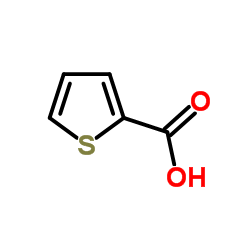Differential reactivity of thiophene-2-carboxylic and thiophene-3-carboxylic acids: Results from DFT and Hartree-Fock theory.
Salvatore Profeta, V S Senthil Kumar, Richard Austin, S Stanley Young
Index: J. Mol. Graph. Model. 28(6) , 540-7, (2010)
Full Text: HTML
Abstract
In the course of investigating the propensity of aromatic acids to react with selected nucleophiles, we came across an interesting difference in yields for two structurally similar thiophene carboxylic acids. Given that these yields were consistent across more than 40 repetitions for each structure, we felt that the difference was real, and worth exploration. To extract the potential steric and electronic origins of such differences, we employed both DFT B3LYP/6-31G* and HF/6-311+G** levels of theory to evaluate structures and energetics. Two somewhat different pictures emerge of the origin of the differences between the carboxylic acids and their individual conformations. In particular, Hartree-Fock calculations with the larger 6-311+G** basis set, which includes multiple diffuse functions, show a profound difference in the delocalization of the LUMO, relative to the DFT method which, expectedly, provides a more localized picture of the contributions to the LUMO. For each of the conformers, the molecular electrostatic potential and the ionization potential (ESP and IP, respectively), together with charge distributions, dipole moments and orbital energies have been explored. A potential explanation for the somewhat more reactive character of the thiophene-2-carboxylic acid appears to arise from the presence of a conformer which has an internal hydrogen bond to the thiophene sulfur, which, in turn, polarizes the acid function significantly relative to other conformers, and optimizes the angle of attack of the nucleophile.Copyright 2009 Elsevier Inc. All rights reserved.
Related Compounds
| Structure | Name/CAS No. | Molecular Formula | Articles |
|---|---|---|---|
 |
Thiophene-2-carboxylic acid
CAS:527-72-0 |
C5H4O2S |
|
Drug-loaded gold/iron/gold plasmonic nanoparticles for magne...
2015-08-01 [Biomaterials 61 , 95-102, (2015)] |
|
Comparative in vitro anti-hepatitis C virus activities of a ...
2008-09-01 [Antimicrob. Agents Chemother. 52 , 3433-7, (2008)] |
|
Carbon dioxide utilization via carbonate-promoted C-H carbox...
2016-03-10 [Nature 531 , 215-9, (2016)] |
|
Discovery of thiophene-2-carboxylic acids as potent inhibito...
2004-02-09 [Bioorg. Med. Chem. Lett. 14(3) , 793-6, (2004)] |
|
In search of oligo(2-thienyl)-substituted pyridine derivativ...
2011-10-10 [Chemistry 17(42) , 11838-43, (2011)] |